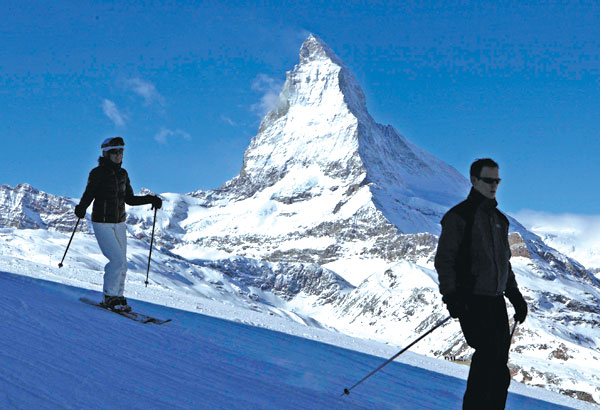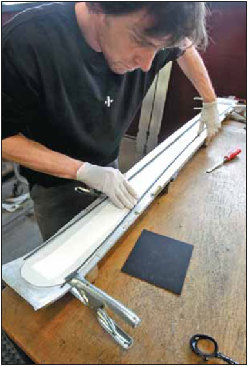Swiss ski resorts bounce back
|
Skiers speed downhill in front of the Matterhorn at Riffelberg in the ski resort of Zermatt. Denis Balibouse / Reuters |
Long valued as a top-class skiing destination, Switzerland has suffered in recent years due to the strength of the franc, causing many skiers to head for cheaper eurozone nations. This winter season, Switzerland hopes for a revival, helped in part by the creation of new luxury resorts. Reuters looks at what's on offer in this winter wonderland.
Prospects are bright for Switzerland's winter tourism industry, which is pinning its hopes on a slew of new luxury developments and bigger, better ski resorts to get back to growth.
Aside from skiing, Switzerland has long been a prized winter destination due to an abundance of high-end shopping, luxury hotels and spas.
Resorts in western Switzerland compete with destinations across the border in eurozone France, including Avoriaz, Megeve and Meribel, where former Formula One champion Michael Schumacher suffered a skiing accident in December.
Meanwhile, ski areas closer to Zurich have ceded ground to cheaper Austrian resorts. The persistent strength of the Swiss franc, which the central bank capped in 2011 to protect the economy, caused tourism to suffer.
Overnight hotel stays in mountain regions dropped off sharply and visitors from Europe declined at a particularly dramatic rate.
That has changed this winter, which is the key tourism season for Switzerland's mountainous regions.
Basel expects a healthy 2.9 percent rise in hotel stays, helped by a rising number of tourists from Asia and Eastern Europe.
Here are some tips for getting the most out of an upmarket Swiss skiing holiday:
Let it snow
|
An employee of Swiss ski producer Zai puts a layer on a ski at the factory in the central Swiss town of Disentis. Arnd Wiegmann / Reuters |
Switzerland's Alps got a plentiful supply of snow just as the winter season started but the franc still hovers perilously high against the euro and the US dollar.
So what has changed to make Switzerland attractive again?
Far better infrastructure and greater supply of luxury accommodation to attract the upper crust is part of the answer but also savvy marketing techniques like cut-rate prices on ski passes even in the ritziest of resorts like St. Moritz.
Some projects are hugely ambitious and have been years in the making. Egyptian billionaire Samih Sawiris has spent eight years on an estimated $2 billion project in Andermatt, a sleepy village of just more than 1,500 people in Uri that no one outside of Switzerland had heard of.
Sawiris, who runs tourist resorts and real estate projects for the sprawling Orascom corporate empire, is seeking to rouse Andermatt from years of neglect by reinventing it as a year-round resort with luxury hotels and apartments, chalets, spas and an 18-hole golf course.
Part of the plan is to merge Andermatt's ski slopes with nearby Sedrun's, but that will not be finished until 2016 due largely to wrangling over zoning.
Another project has ski resorts Arosa and Lenzerheide consummating a merger last month to form 225 kilometers of slopes, which will put it among Switzerland's top 10 ski regions.
Further southwest in the Val d'Anniviers valley, resorts Zinal and Grimentz were linked up last month via cable car.
Verbier, long popular with British tourists including Sarah Ferguson, and Crans-Montana are among those posh Swiss resorts in French-speaking Switzerland that increasingly draw wealthy Russian clients to their slopes and apres-ski nightlife. The granddad of Swiss ski resorts remains St. Moritz with 350 km of prepared pistes, a winter polo tournament on its frozen lake and the fabled Cresta toboggan run.
St. Moritz is one of Switzerland's most expensive and exclusive resorts but it also offers the cheapest ski pass at 25 Swiss francs ($27.50) a day if you stay more than two nights.
















